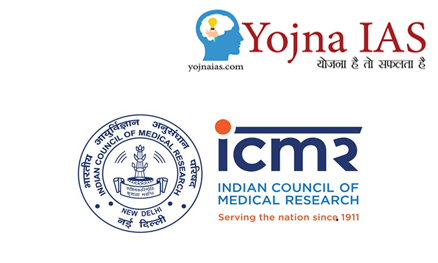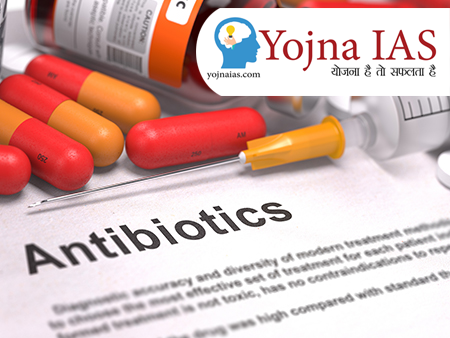12 Jan 2024 Increasing use / Over- prescription of antibiotics in India.
Source – The Hindu and PIB.
General Studies: A comprehensive health approach, Antimicrobial Resistance (AMR), National Center for Disease Control (NCDC), Indian Council of Medical Research (ICMR), World Health Organization (WHO).
Why in the News ?
- The National Center for Disease Control (NCDC) in one of its recent surveys, amid growing concerns about Antimicrobial Resistance (AMR) in India, found several concerns regarding the overuse of antibiotics in India. The major findings have been published. India is the largest consumer of antibiotics in the world. Excessive antibiotic use in India is causing powerful mutations never seen before in bacteria.

Main findings of this survey :
Use of antibiotics as preventive measures in India :
- The survey found that more than half of patients (55%) in India were advised to use antibiotics for prophylactic indications rather than for therapeutic purposes (45%), primarily to prevent infection..
Antibiotic Prescription Format in India :
- In India, only a small number of patients (6%) were given antibiotics to treat their disease based on the diagnosis of some specific bacteria, while the majority of cases (94%) were given antibiotics based on the doctor’s clinical assessment of the probable cause of the disease. But were on empirical therapy.
Lack of specialized clinical medical system in India :
- The survey found that prevalent use of antibiotics without accurate knowledge of the cause of infection resulted in 94% of patients being given antibiotics before a definite medical diagnosis was confirmed, reflecting the lack of a specific clinical medical system in India.
Variation among hospitals :
- Wide variations were found in antibiotic prescription rates across hospitals, ranging from 37% to 100% of patients prescribed antibiotics.
- A significant proportion (86.5%) of antibiotics prescribed were given through the parenteral route (not orally).
Drivers of AMR :
- NCDC in its survey states that one of the main factors for the development of antibiotic resistance is excessive and inappropriate use of antibiotics.
Antibiotics and Drug Resistance : An Introduction :
- Antibiotics kill bacteria and stop their growth. It is a broad group of disease-modifying compounds used to prevent infections caused by bacteria, molds, and other parasites, including fungi and protozoa that can be seen under normal microscopes.
- Antibiotics are remarkable medicines that are capable of killing biological organisms in one’s body without causing harm to the body.
- They are used for everything from preventing infection during surgery to protecting cancer patients undergoing chemotherapy.
Antibiotics are divided into two groups due to their action or effect –
Bactericidal agents.
Bacteriostatic agent.
- Those which kill bacteria are called ‘bactericidal agents’. And
- Those which weaken the growth of bacteria are called ‘bacteriostatic agents’.
- Penicillin is a bactericidal antibiotic. It attacks the cell wall or cell membrane of the bacteria. Antibiotics are also known as antibacterial.
- The immune system of the human body has the ability to remove infections caused by bacteria, but sometimes the attack of bacteria becomes so much that the immune system of the human body is unable to remove the infection. goes beyond the capacity of the system). To avoid such infections, humans have to take antibiotics externally.
- India meets about 20% of the global demand for generic drugs across the world. Therefore, India is one of the largest producers and exporters of pharmaceutical products. India is among the top 12 leading institutions / locations for biotechnology in the world. India is the third largest exporter of biotechnology in the Asia-Pacific region.
- India’s pharmaceutical industry has made a significant contribution across the world in improving health outcomes and access to affordable medicines for millions of people in the developing countries. At times, India’s pharma industry has also faced various allegations and incidents of producing substandard, contaminated or harmful drugs, which has led to adverse effects on patients in many countries like Sri Lanka, Gambia, Uzbekistan, United States of America etc. There have also been deaths of patients.
- These incidents have given rise to serious concerns regarding the role and effectiveness of the Indian drug regulator in ensuring compliance with standards and norms such as quality and safety/non-harmfulness of Indian pharma products.
Drug resistance :
- Drug resistance occurs when antibiotics are overused in treating humans, animals as well as plants.
- Antibiotic resistance has the potential to affect people at any stage of life. When a person is infected with antibiotic-resistant bacteria, not only does it become difficult to treat that patient, but the antibiotic-resistant bacteria can also spread to other people.
- When antibiotics do not work, the patient’s condition may lead to more complex diseases, use of stronger and more expensive drugs, and gradual bacterial infections leading to more deaths.
- The spread of antibiotic resistance around the world is undermining decades of progress in fighting bacterial infections.
Result of Research / Conclusion :
- Antibiotic adjuvants are non-antibiotic compounds that enhance antibiotic activity by blocking resistance or enhancing the host response to infection.
- The scientists incorporated cyclic hydrophobic moieties (part of a molecule) into a compound containing triamine / triamine, a compound consisting of three amino groups, thus weakly irritating the membrane of the evolved helper bacteria. Are.
- Resistance to antibiotics occurs through a variety of molecular mechanisms, including decreased drug permeability, activated efflux, alteration or bypass of drug targets, production of antibiotic-modifying enzymes, and physiological conditions such as biofilms that block antibiotic activity. Are less sensitive.
- Efflux pumps reduce intracellular antibiotic concentrations, allowing bacteria to survive high antibiotic concentrations.
- When these adjuvants are used in combination with antibiotics that had become ineffective due to such membrane-associated resistance elements, the antibiotics become potent, and the combination is effective in killing the bacteria.

Importance of scientific study :
- The study found that these antibiotics can combat the most important groups of bacteria, enabling existing antibiotics to be repurposed for complex infections. This can help combat the growing threat of antimicrobial resistance (AMR).
- This could help strengthen the activity of obsolete antibiotics and bring them back into use to treat complex infections.
Important initiatives related to drug resistance by India:
- National Program on AMR Prevention : Under this programme, launched in 2012, the AMR surveillance network has been strengthened by setting up laboratories in state medical colleges.
- National Action Plan on AMR : Launched in April 2017, it focuses on a one health approach and was initiated with the aim of involving various stakeholder ministries/departments.
- AMR Surveillance and Research Network (AMRSN) : It was launched in 2013 to generate evidence and capture trends and patterns of drug-resistant infections in the country.
- AMR Research and International Collaboration : Indian Council of Medical Research (ICMR) has taken initiatives to develop new drugs/medicines through international collaboration to strengthen medical research in AMR.
- Antibiotic Stewardship Programme : ICMR has launched Antibiotic Stewardship Program (AMSP) on a pilot project across India to control the misuse and overuse of antibiotics in hospital wards and ICUs.

Important initiatives related to drug resistance at global level :
- World Antimicrobial Awareness Week (WAAW) : Held annually since 2015, WAAW is a global campaign aimed at raising awareness of antimicrobial resistance around the world and empowering the general public, health and society to slow the development and spread of drug-resistant infections. The aim is to encourage best practices among activists and policy makers.
- Global Antimicrobial Resistance and Use Surveillance System (GLASS) : WHO launched GLASS in 2015 to address knowledge gaps and inform strategies at all levels. Glass is envisioned to systematically incorporate data from monitoring AMR in humans, monitoring the use of antimicrobial drugs, and AMR in the food chain and environment.

Conclusion / Solution :
- Antibiotics are a boon for the animal world. According to medical experts, there are many life-saving medicines which cannot be given without antibiotics. If the use of antibiotics continues indiscriminately, then more new superbugs will be seen and gradually we will have to stop the use of antibiotics completely. Global efforts are also expected in this regard, if this does not happen then the medical science on the basis of which Alexander Fleming’s invention has flourished so much today will go far behind the global health needs of the present time.
- In the year 2012, a comprehensive plan was made in the ‘Chennai Declaration’ to deal with the growing threat of superbugs, which was also included in the 12th Five Year Plan. In the plan started in the 12th Five Year Plan, it was talked about the establishment of 30 such laboratories which would work towards solving the problems arising from excessive use of antibiotics, but till now only 10 such laboratories have been constructed. The government will have to find ways to prevent superbugs and for this, research will have to be encouraged.
- At present, no pharmaceutical company in the world is going to prepare any new antibiotic medicine for the next 20 years. This campaign has been started to prevent excessive use of antibiotics. To prevent excessive use of antibiotics, the government has issued a new list of salable medicines and has instructed drug sellers to sell medicines based on it, but the availability of antibiotics easily anywhere is worrying, hence the government should strengthen its monitoring system. We have to be more alert, so that humans can remain conscious about their health and disease free.
Download Yojna daily current affairs eng med 12th Jan 2024
Practice Questions for Preliminary Exam :
Q. 1. Consider the following statements regarding excessive use of antibiotics in India.
- India is the largest consumer of antibiotics in the world.
- Antibiotics are remarkable medicines that are incapable of killing biological organisms in one’s body without causing harm to the body.
- NCDC in its survey states that one of the main factors for the development of antibiotic resistance is excessive and inappropriate use of antibiotics.
- India meets about 80% of the global demand for generic drugs.
Which of the above statement / statements is correct ?
(A) Only 1, 2 and 3
(B) Only 2 and 4
(C) Only 1 and 3
(D) All of these.
Answer – (C)
Practice Questions for Main Exam :
Q.1. Discuss how the overuse and free availability of antibiotics without doctor’s advice may contribute to the emergence of drug-resistant diseases in India? Critically analyze the various issues involved in overuse and free availability of antibiotics.
Qualified Preliminary and Main Examination ( Written ) and Shortlisted for Personality Test (INTERVIEW) three times Of UPSC CIVIL SERVICES EXAMINATION in the year of 2017, 2018 and 2020. Shortlisted for Personality Test (INTERVIEW) of 64th and 67th BPSC CIVIL SERVICES EXAMINATION.
M. A M. Phil and Ph. D From (SLL & CS) JAWAHARLAL NEHRU UNIVERSITY, NEW DELHI.


No Comments